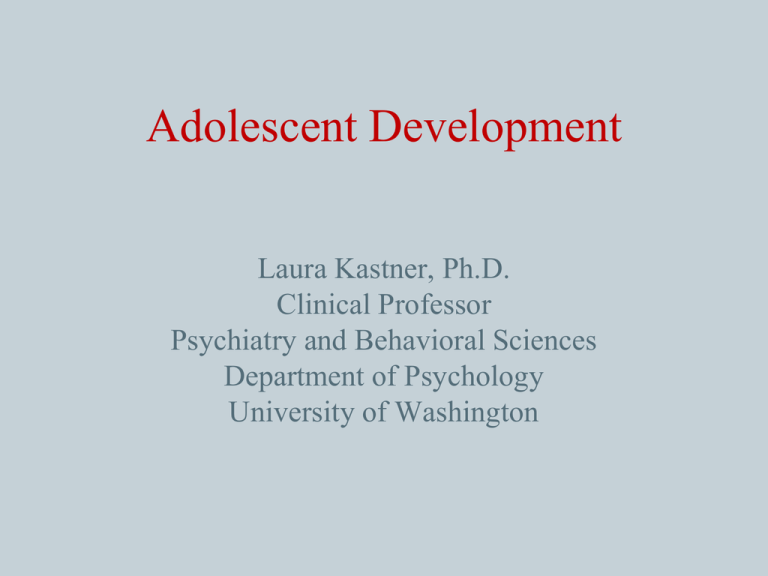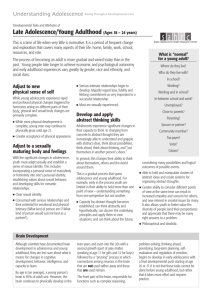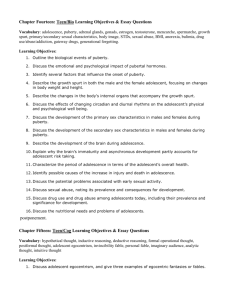Psychosocial Development and Social Context During Adolescence
advertisement

Adolescent Development Laura Kastner, Ph.D. Clinical Professor Psychiatry and Behavioral Sciences Department of Psychology University of Washington “I’m wondering about Sarah… “Sarah (15) smokes pot with her friends almost every weekend. She says she can’t talk to her parents about anything, and that they annoy her constantly. Her grades have gone down since she started high school this year. She says that all she wants to do is be online with her friends and blog. Feeling like an “outcast” at school, she admits to acting like she is more experienced sexually than she really is for her blog. She reports that she has not had sexual intercourse yet: “I only like to hook up and “mess around”.” “A website on drug abuse cited these warning signs: • withdrawal • moodiness • increased family conflict • argumentativeness • over-reactivity to criticism • sloppiness in appearance • spending time isolating in room • poor attitude • disrespect • loss of interest in family activities.” “Does Sarah have a drug abuse problem?” Late (17-18) Early (10-13) SSSssS Social So . Emotional Increased desire to be with friends; push for greater independence; less contentment in being exclusively with family; increased identification with peer culture; value on independence and individualism highly influenced by culture and ethnicity Increased moodiness, irrational behavior, emotional reactivity and impulsivity related to puberty and changes in the prefrontal cortex. Middle (14-16) Identity formation and values exploration; strong preference for the company of friends, but still connected to parents for support, desire for approval and long-term attachments; peer conformity is driven by strong desire for peer acceptance Integration of values internalized from parents, experience and generational influences; friendship choices less related to similar interests and more to valued individual characteristics and qualities; intimacy increasingly sought. Increased arousal and novelty seeking; low motivation for what is perceived as boring; increased conflict with parents; emotional dysregulation results from “amygdala hijacks.” Growing ability to recognize and manage emotions, demonstrate empathy, resolve conflicts constructively and work cooperatively with others. Physical Development • Bodily changes resulting from pubertal development • Anxiety and self-consciousness • Sexual identity development • Puberty stimulates changes in the intensity and duration of affective states and drives Cognitive Development • Shift from concrete to formal operations: increasing ability to understand abstract concepts, symbolic thought and hypothetical ideas (Piaget) • Adolescents’ cognitive style has been characterized as “egocentrism,” and includes “myth of immunity”, denial, poor risk assessment, and irrational beliefs (Elkind, Erikson). • And then came neuroscience… The Thinking Brain Emotion Brain Emotion Brain-(limbic system) fears/rewards Amygdala-fear and anxiety center (fight, flight, flood) • Also hypocampus, ventral striatum, hypothalamus, nucleus accumbens The reward pathway in the “emotion brain” (dopamine surge—I WANT IT!) Brain Maturation Research • Significant “pruning” of the prefrontal lobes starting around age 13, without full maturation until early 20’s. • Much of the poor decision-making skills which have been attributed to “raging hormones” is probably also a result of this brain remodeling process. Teen Brain NASCAR Metaphor • Big engine—maturing bodies, independence-striving • Poor Driver—immature PFC and judgment • Faulty Brake system—immature inhibitory mechanisms in PFC • High octane fuel—hormones Put simply…… • During adolescence, behavior is often more governed by the emotional centers than the thinking centers of the brain, especially during high arousal situations and in peer presence. Emotional Regulation 101: Teaching Brain Basics • The limbic system, or “emotion brain”, has evolved to guide us about what is desirable and undesirable for survival. It “triggers” when we are afraid, angry, distressed and upset. • The amygdala is the fear and anxiety center, triggered by truly life threatening events and false alarms (“flooding”). • The “neo-cortex” houses the “thinking” brain (“prefrontal cortex, the “CEO”), which allows us to plan ahead, weigh costs and benefits of options for decision making, and control our impulses. Adolescence is an era of high risk and high opportunity. • “Use it or lose it” in neuroscience refers to the need to use the brain “like a muscle” in order to stimulate new connections. • Changes in circadian rhythms alter alert-fatigue signals, affecting memory and biorhythms. Sleep problems are common, especially with the overuse of media. • Teens differ from adults in their dopaminergic systems and reward sensitivity, with implications for increased risk-taking, vulnerability to drug addiction and intense media attraction and compulsivity. (Casey, Galvan et al (2008) Developmental Review“Braking and Accelerating in Adolescent Brain” Developmental research qualifiers: • Marked changes in moodiness, emotional reactivity and risk-taking among adolescents are neither universal or inevitable (but they are more likely than not) • Although gender, culture and age differences among adolescents can be important, temperament is a powerful predictor of behavior • What is interpreted as “normal” depends on the one’s psychosocial assessment, sophistication of knowledge about adolescence and personal “filters.” Ethnic Diversity • Developing a strong ethnic identity contributes to high self-esteem among ethnic minority adolescents (Carlson et al, 2000). • Parents and role models are key for establishing pride in shared values, traditions and practices of a cultural group. • Adolescence may be the first time they reflect on the implications of their group identification. Culture mediates… everything? • Ethnic identity is influenced by parent messaging in minorities (Boyd-Franklin) • Values vary (respect for elders, religion sexuality, racism, individualism, selfexpression and shame) • Family assumptions and alpha/beta errors (Sue) • Americanization in first generation immigrants • Implications for psychiatric dx and tx Neuroendocrine system changes • Testosterone in boys can increase by 100% by the end of puberty, and 20 X more than girls of same age. • Amygdala has receptors for testosterone, which probably contributes to increased novelty seeking, territoriality and exploration for stimulation. • Hormones have impact on neurotransmitters, moods and symptoms: norepinephrine (energizer); dopamine (pleasure); and serotonin (mood stabilization, relaxation, confidence) Sensitivity of the teen brain to substances • Alcohol stimulates the release of dopamine during the “sensitive period” of adolescence, decreasing the natural production. • Heavy alcohol use interferes with memory and glutamate functioning. • Nicotine stimulates dopamine supply and affects other neurotransmitters, allowing rapid addiction. • Dopamine “squirts” result from computer games, stimulating media, gambling and other high arousal pursuits. Social Development • Increased preference for the company of peers and greater autonomy from parents. • Gender patterns; “perfect girl prototype” (SteinerAdair) pressures and “hypermasculine” boy (Pollock, Thompson). • Parental influence still prevails in families with parent-child connectedness and authoritative discipline. • Peer influence is greatest in areas of taste, customs, and generational issues. • Positive peer influence is underestimated. Family Development • Storm and stress is not inevitable or universal among adolescents, but it is more likely than not. • Random moment sampling reveals that young teens experience negative thoughts and feelings in the company of their parents at 10X rate of other settings (Csikszentmihalyi, Larson). • Most families experience higher parent-child conflict, more teen behavioral experimentation and more teen mood lability during ages 11-16. Identity Development • Identity formation involves questioning values and the status quo, especially re: politics, religion, sexuality, substance use, and future goals (“ego development” research: Marcia, Loevinger). • Parents who share their own values, support the questioning and identity growth process, and are “authoritative” in their parenting style produce the most well-adjusted young adults (Grotevant, Allen). Hot Topics in Adolescent Development • • • • • • Risk-taking and prevention Emotional regulation, motivation & self control Emotional and social competence Effects of media & media literacy Sleep deprivation Stress reduction (mindfulness, exercise, healthy eating) • Bullying • Family health Adolescent Risk • Developmentally adaptive for most, but harmful to others. • Early adolescence is a time of particular vulnerability • The role of context in the development of risk-taking plays a role in protecting or exacerbating the adaptation of individuals with regulatory vulnerabilities. Adolescent Risk-taking • Adolescents engage in dangerous activities despite understanding (cognitively) the risks involved. • Actions are determined by feelings, impulses, opportunity, and the functioning (or lack thereof) of the “executive suite”in the frontal lobes (planning, monitoring, evaluating, and reflecting). Biological risks • Family or child psychiatric illness, mental disorder, trauma • Family or child antisocial history • Family or child substance abuse Child’s individual risks • Child behavior problems (conduct, ADHD, aggressive/disruptive) • School problems (failure, poor performance, truancy, low investment in school) • Early risk-taking and substance use • Alienation, rebelliousness, peer rejection and lack of social bonding to pro-social endeavors and society Social risks • • • • • • • Poverty Deficient schools and opportunities Dangerous neighborhoods Lack of positive role models Peer risk-taking Social isolation/lack of social support Lack of connection to school Protective variables which enhance resilience (Masten, Garmezy, Rutter) • High intelligence • Adaptable temperament • School commitment/value on achievement/quality schools • Parenting quality/secure attachment • Value on health, future goals and pro-social moral code • Extracurricular activities/opportunities for positive youth engagement Family management risks • Poor supervision • Poor boundaries, authority and problem-solving skills • Difficulties in marriage, couple or single parenthood • Inconsistent/permissive/authoritarian parenting style • Negative communication patterns • Physical or emotional maltreatment • Parental tolerance of deviance Parenting as a key mediator to adverse life experiences • Family cohesiveness and parent connectedness are cornerstone protective variables (Resnick). • Research on authoritative parenting indicates the importance of high control, effective communication and warmth (Baumrind, Steinberg). • Parental intrusiveness ( psychological control/parental anxious emotional involvement/enmeshment) is a risk variable (Barber). What are the biggest hot button issues for parents during the teen years? (14 chapters of “Getting to Calm”) • • • • • • • • • • • • • • Rudeness, sassiness and the morphing into a teen Risk-taking, defiance, rule breaking Lying, exaggeration (distorting the truth) and dishonesty Parent polarization (when parents don’t agree) Entitlement, spoiled behaviors Distancing and disconnection (identity issues) Picking fights in various ways (emotional regulation, gender issues) Peer issues, fear of negative influence Over-Plugged into media and electronics Teen romance Sex Disappointing academic performance Substance use Stressed-out families and kids (40% of teens 13-18 have lifetime prevalenceof mental illness, Merikangas et al ., J Am Acad Ch Adol Psychiatry. 2010)





